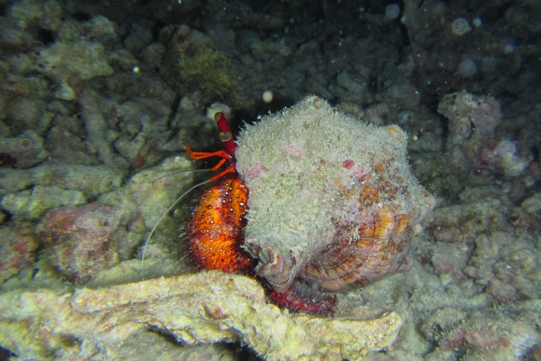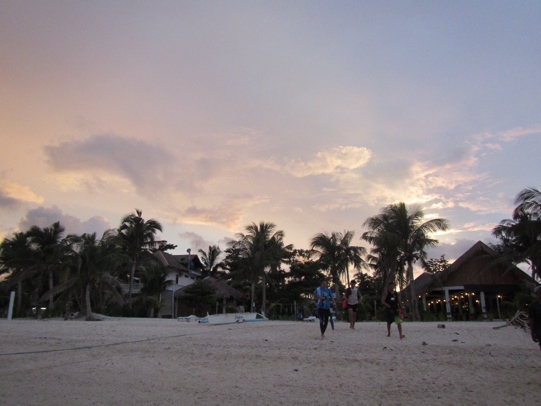After leaving Palau we had another marathon trip to get to Malapascua in the Philippines. Our flight was due to leave at 00:20, so we went straight to the airport the previous evening. As it wasn’t full, it managed to leave about an hour earlier, and so we arrived in Guam an hour early at 04:30 (with a quick stop in Yap to drop off and pick up some people). After suffering through an hour long immigration queue, we found ourselves sitting around wondering what to do with the next 13 hours until our flight to Manila left. Unfortunately there is not a huge number of things to do in Guam, so we spent the day catching up on emails, eating and wandering around some of the shops. We arrived in Manila at 21:30, headed to our hotel (conveniently located near the airport) for a few hours slept before our next flight to Cebu City at 07:00 the next morning (top tip: arrive at the airport at least two hours in advance for domestic flights – we got there 1 hour 40 minutes before our flight and had to hurry to the boarding gate). After arriving in Cebu we had a 3 hour car ride (accompanied by a ‘Best of Modern Talking’ CD on repeat – not my happiest time ever) followed by a 30 min boat ride before we finally arrived in Malapascua Island.
Malapascua is famous for being the only place in the world where you can reliably see thresher sharks. These sharks normally live in the deep ocean (100m and deeper) but at Malapascua they come up to a depth of around 20m at dawn to be cleaned by wrasses. They are really beautiful sharks which grow up to 6m in length, half of which is made up by their long tail, which is used to stun their prey underwater. They have huge dark eyes to help them see in the depths, and a beautiful shimmery skin. We had been wanting to see them for ages, and this was the main reason that we headed out to Malapascua. We had booked to stay for 3 nights, giving us 2 early dives to see the sharks, with some time to do a few other dives in the area. In the end we only needed one dive, as we were fortunate to have the best dive in a month on our first attempt, with around 7 sharks turning up (including 3 at one time) and with the sharks coming within 2m of us. The whole experience was amazing is something we recommend that anyone with an interest in sharks does. The low light conditions were a little beyond the capabilities of our little Canon D30, but we still managed to get some reasonable pics:



What we weren’t expecting is how great the rest of the diving we did was. The Philippines is part of the coral triangle which has a incredible array of underwater creatures, but we’ve never heard much about the diving in Malapascua other than the thresher sharks, so we weren’t expecting much. Boy, were we wrong. We ended up doing 2 night dives, a wreck dive and 3 dives around Gato Island, a tiny island 45 minutes boat ride from Malapscua with a 35m underwater tunnel going from one side of the Island to the other. On every dive we saw an amazing array of small critters, ranging from colourful nudibranchs (or sea slugs), stacks of cuttlefish, a sea snake, sea horses, pipefish, unusual fish, weird shaped crabs, shrimps (including some tiny skeleton shrimps) and best of all, the very elusive and rare blue ringed octopus. This tiny but incredibly poisonous octopus is something Anne and I have been wanting to see since we first dived in the coral triangle 5 years ago. We’ve specifically gone to places where there is a chance to see them, with no luck, and to finally see one in a place where it was completely unexpected, was fantastic. The scary thing is that we are now heading to the places in the Phillipines which are renowned for their critters, so I can’t imagine what we are going to see there. The dive count is now 51 dives in 5 weeks. Here are a few pics of just a few of the things we saw on our dives (non-divers: feel free to skip past the many photos to the next section).




































One last think I’d like to mention about Malapascua is the fantastic resort we stayed at, Evolution Divers. From our first email contact with them up until we left they were awesome. Every email was answered promptly, they were very helpful with our travel arrangements, great accommodation, very professional dive operation, great restaurant and fabulous staff. The costs were very reasonable (around USD40 for the room per night including breakfast, dives around USD30 – 45, depending on the distance, beers USD1 and meals USD5 – 7.50). Highly recommended. We also met some great people at the resort, including the some Aussies, a guy from Turkey and 2 Dutch couples.


We’re now on our way to Dauin near Dumaguete, famous for muck diving as well as coral diving at nearby Apo Island. It’s another long journey (30 minute boat ride, 6 hours by car, another short boat ride and then a short car ride). The Modern Talking has started up again, and so it is with the europop beat of Geronimo’s Cadillac that I say goodbye until next time!
Links
1. Evolution Resort: http://evolution.com.ph
2. Modern Talking: http://en.m.wikipedia.org/wiki/Modern_Talking

I’m so thrilled to see your post. I am looking forward to diving in Malapascua, as well.
Enjoy your stay on Apo Island. Say “hello” to the turtles for me! 🙂
I want to try this too!!!
Stunning – However, do what you like Dave – just send Anne back !!
Leonie – I tried to make her stay but she was having none of it 😦